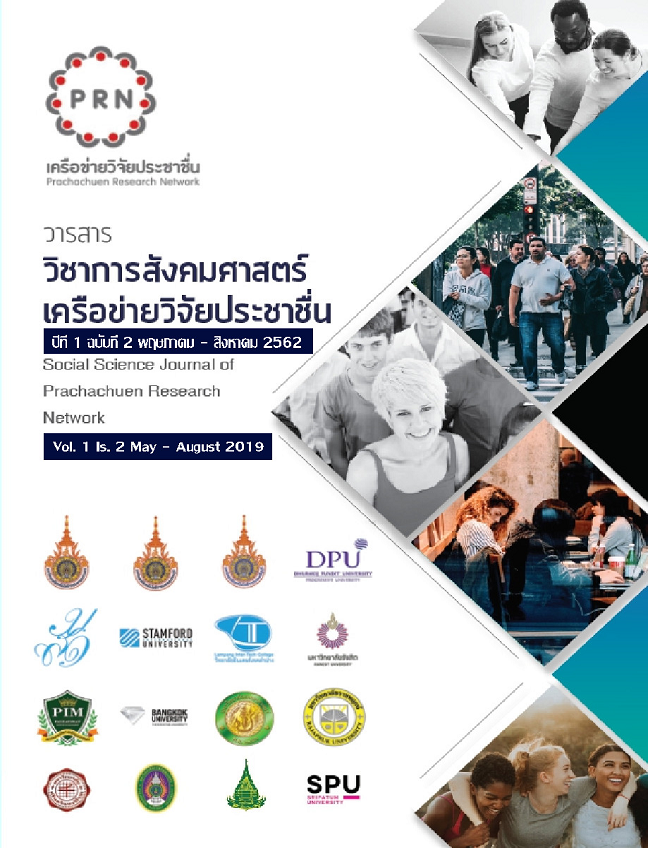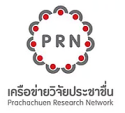ปัจจัยที่ส่งผลต่อความพึงพอใจในการใช้บริการการเช็คอินด้วยตัวเองด้วยตัวเอง ที่ตู้คีออสของสายการบินไทยแอร์เอเชีย
คำสำคัญ:
คุณภาพการให้บริการ, ความพึงพอใจ, การเช็คอินด้วยตัวเอง, สายการบินไทยแอร์เอเชียบทคัดย่อ
การศึกษางานวิจัยเรื่อง “ปัจจัยที่ส่งผลต่อความพึงพอใจในการใช้บริการการเช็คอินด้วยตัวเองที่ตู้ คีออสของสายการบินไทยแอร์เอเชีย” เป็นการวิจัยเชิงสำรวจ และวัตถุประสงค์ของการศึกษาในครั้งนี้ เพื่อ 1) ศึกษาลักษณะทางประชากรศาสตร์ คุณภาพการให้บริการ และความพึงพอใจในการใช้บริการการเช็คอินด้วยตัวเองที่ตู้คีออสของสายการบินไทยแอร์เอเชีย 2) เปรียบเทียบความพึงพอใจในการใช้บริการการเช็คอินด้วยตัวเองที่ตู้คีออสของสายการบินไทยแอร์เอเชีย จำแนกตามปัจจัยส่วนบุคคล และ 3) ศึกษาอิทธิพลของคุณภาพการให้บริการที่มีผลต่อความพึงพอใจในการใช้บริการการเช็คอินด้วยตัวเองที่ตู้คีออสของสายการบินไทยแอร์เอเชีย กลุ่มตัวอย่างที่ใช้ในการศึกษาครั้งนี้ เป็นกลุ่มประชากรที่มาใช้บริการการเช็คอินด้วยตัวเองที่ตู้คีออสของสายการบินไทยแอร์เอเชีย โดยใช้แบบสอบถามในการเก็บข้อมูลด้วยวิธีการซุ่มตามความสะดวก จำนวน 300 คน ในการวิเคราะห์ข้อมูล ผู้วิจัยใช้สถิติเชิงพรรณนา ประกอบด้วย ความถี่ ร้อยละ ค่าเฉลี่ยและส่วนเบี่ยงเบนมาตรฐาน และใช้สถิติเชิงอนุมาน ประกอบด้วย การทดสอบความแตกต่างของค่าเฉลี่ย การทดสอบความแปรปรวนทางเดียว และการวิเคราะห์การถดถอยเชิงพหุคูณแบบขั้นตอน
ผลการศึกษาพบว่า ผู้ใช้บริการสายการบินไทยแอร์เอเชียที่มี เพศ อายุ อาชีพ ระดับการศึกษา รายได้ต่อเดือน และการเดินทางแตกต่างกัน มีความพึงพอใจในการเช็คอินด้วยตัวเองที่ตู้คีออสแตกต่างกัน สำหรับการวิเคราะห์การถดถอยเชิงพหุแบบขั้นตอน พบว่า คุณภาพการบริการในการเช็คอินที่ตู้คีออสในด้านการดูแลเอาใจใส่ (β = .494) ด้านความน่าเชื่อถือ (β = .239) และด้านความไว้วางใจ (β = .156) มีอิทธิพลต่อความพึงพอใจในการเช็คอินด้วยตัวเองที่ตู้คีออส อย่างมีนัยสำคัญทางสถิติที่ระดับ 0.05
เอกสารอ้างอิง
กฤษดา เชียรวัฒนสุข และสุรพร อ่อนพุทธา. (2560). การจำแนกกลุ่มลูกค้าที่คำนึงถึงราคาและคำนึงถึงคุณภาพก่อนตัดสินใจซื้อ โดยใช้ปัจจัยส่วนประสมการตลาดบริการ (7PS). วารสารวิชาการการตลาดและการจัดการ มหาวิทยาลัยเทคโนโลยีราชมงคลธัญบุรี, 4(2), 70-87
Ahmad, R., & Neal, M. (2006). AirAsia: The Sky's the Limit. Asian Journal of Management Cases, 3(1), 25-50.
Barsky, J. D., & Labagh, R. (1992). A strategy for customer satisfaction. Cornell Hotel and Restaurant Administration Quarterly, 33(5), 32-40.
Best, W. J., & Kahn, V. J. (2006). Research in education. Tenth Edit. United States of America: A and B Pearson.
Djelassi, S., Diallo, M. F., & Zielke, S. (2018). How self-service technology experience evaluation affects waiting time and customer satisfaction? A moderated mediation model. Decision Support Systems, 111, 38-47.
Ganiyu, R. A. (2016). Perceptions of Service Quality: An Empirical Assessment of Modified SERVQUAL Model among Domestic Airline Carriers in Nigeria. Acta Universitatis Sapientiae, Economics and Business, 4(1), 5-31.
Ghotbabadi, A. R., Feiz, S., & Baharun, R. (2015). Service quality measurements: a review. International Journal of Academic Research in Business and Social Sciences, 5(2), 267.
Greenwell, T. C., Fink, J. S., & Pastore, D. L. (2002). Assessing the influence of the physical sports facility on customer satisfaction within the context of the service experience. Sport Management Review, 5(2), 129-148.
Jiang, H., & Zhang, Y. (2016). An investigation of service quality, customer satisfaction and loyalty in China's airline market. Journal of air transport management, 57, 80-88.
Hajiar, S. T. (2014). A statistical study to develop a reliable scale to evaluate instructors within higher institution. WSEAS Transactions on Mathematics, 13, 885-894.
Khan-Am, W., & Rangsom, K. (2016). Applying Innovation Characteristics in Technology Acceptance Model Innovation Acceptance Model. International Journal of Applied Computer Technology and Information Systems, 4(2), 5-9.
Lahap, J., Ramli, N. S., Said, N. M., Radzi, S. M., & Zain, R. A. (2016). A Study of Brand Image towards Customer's Satisfaction in the Malaysian Hotel Industry. Procedia-Social and Behavioral Sciences, 224, 149-157.
Liu, Y., & Jang, S. S. (2009). Perceptions of Chinese restaurants in the US: what affects customer satisfaction and behavioral intentions?. International Journal of Hospitality Management, 28(3), 338-348.
Luo, X., & Bhattacharya, C. B. (2006). Corporate social responsibility, customer satisfaction, and market value. Journal of marketing, 70(4), 1-18.
Menard, S. (2000). Coefficients of determination for multiple logistic regression analysis. The American Statistician, 54(1), 17-24.
Mithas, S., Krishnan, M. S., & Fornell, C. (2005). Why do customer relationship management applications affect customer satisfaction?. Journal of Marketing, 69(4), 201-209.
Neter, J., Wasserman, W. and Kutner, M.H. (1989) Applied Linear Regression Models. 2nd Edition, Richard D. Irwin, Inc., Homewood.
Nyadzayo, M. W., & Khajehzadeh, S. (2016). The antecedents of customer loyalty: A moderated mediation model of customer relationship management quality and brand image. Journal of Retailing and Consumer Services, 30, 262-270.
Oliver, R. L. (1981). Measurement and Evaluation of Satisfaction Processes in Retail Settings. Journal of Retailing, 57(3), 25–48.
Parasuraman, A., Zeithaml, V. A., & Berry, L. L. (1988). SERVQUAL: A multiple-item scale for measuring consumer perc. Journal of retailing, 64(1), 12.
Pourhosein, M. R., Kol, A. A. K., Vishkaii, B. M., & Jourshari, F. P. (2017). Investigate the Relationship between Institutional Ownership in Tehran Stock Exchange. International Journal of Economics and Financial Issues, 7(3), 276-285.
Ricart, J. E., & Wang, D. (2005). Now everyone can fly: Air Asia. Asian Journal of Management Cases, 2(2), 231-255.
Schlesinger, L. A., & Zornitsky, J. (1991). Job satisfaction, service capability, and customer satisfaction: An examination of linkages and management implications. Human Resource Planning, 14(2).
Serin, Balkan, Doğan. (2013). The Effects of Demographic Factors on Perceived Customer Satisfaction between Public and Private Banks: Turkey Example. International Journal of Information Technology and Business Management, 22(1), 1-7
Storbacka, K., Strandvik, T., & Grönroos, C. (1994). Managing customer relationships for profit: the dynamics of relationship quality. International journal of service industry management, 5(5), 21-38.
Taumoepeau, S. (2016). Low Cost Carriers in Asia and the Pacific. The Low Cost Carrier Worldwide, 113.
Taylor, S. A., & Baker, T. L. (1994). An assessment of the relationship between service quality and customer satisfaction. Journal of retailing, 70(2), 163-178.
Thakur, S., & Singh, A. P. (2012). Brand image, customer satisfaction and loyalty intention: a study in the context of cosmetic product among the people of Central India. EXCEL International Journal of Multidisciplinary Management Studies, 2(5), 37-50.
Trisakhon, C., Onputtha, S. & Peamchai, P. (2018). The Effect of External Business Environment on Business Performance of Small and Medium Food Processing Enterprises in Bangkok and Metropolitan Area. In Proceedings of The 14th International conference in Applied Computer Technology and Information System (NCOBA-2018), 23 July 2018.
Tse, D. K., & Wilton, P. C. (1988). Models of consumer satisfaction formation: An extension. Journal of marketing research, 25(2), 204-212.
Ulaga, W., & Chacour, S. (2001). Measuring customer-perceived value in business markets: a prerequisite for marketing strategy development and implementation. Industrial marketing management, 30(6), 525-540.
Vijay Anand, S., & Selvaraj, M. (2013). The impact of service quality on customer satisfaction and loyalty in Indian banking sector: an empirical study through SERVPERF. International Journal of Management and Business Research, 2(2), 151-163.
Xie, X., Jia, Y., Meng, X., & Li, C. (2017). Corporate social responsibility, customer satisfaction, and financial performance: The moderating effect of the institutional environment in two transition economies. Journal of Cleaner Production, 150, 26-39.
Zhang, A., Hanaoka, S., Inamura, H., & Ishikura, T. (2008). Low-cost carriers in Asia: Deregulation, regional liberalization and secondary airports. Research in Transportation Economics, 24(1), 36-50.
ดาวน์โหลด
เผยแพร่แล้ว
รูปแบบการอ้างอิง
ฉบับ
ประเภทบทความ
สัญญาอนุญาต
บทความที่ได้รับการตีพิมพ์เป็นลิขสิทธิ์ของวารสารวิชาการสังคมศาสตร์เครือข่ายวิจัยประชาชื่น







